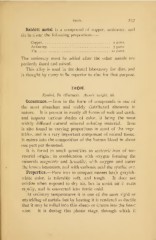Page 249 - My FlipBook
P. 249
IRON. — 237
Babbitt metal is a cninponnd of copper, antimony, and
tin in al)()nt llic followini^' ])roportions :
Copper, 2 parts.
Anlimony 3 parts.
Tin 12 parts.
The antimony mn.st l)e added after the (jther metals are
perfectly fnsed and mixed.
This alloy is used in the dental laboratory for dies, and
is thought by many to be superior to zinc for that purpose.
IRON.
Symbol, Fe (Ferrum). Atomic zccight. 56.
Occurrence.—Iron in the form of compounds is one of
the most abundant and widely distributed elements in
nature. It is present in nearly all forms of rock and earth,
and imparts various shades of color, it being the most
widely diffused natural mineral coloring material. Iron
is also found in varying proportions in most of the vege-
tables, and is a very important component of animal tissue.
It enters into the composition of the human blood in about
one part per thousand.
It is found in small quantities as incteoric-iron of ter-
restrial origin ; in combination with oxygen forming the
minerals inoguciifc and Jicinatitc, with oxygen and water
the brown hematites, and with carbonic acid the spathic ore.
Properties.—Pure iron in compact masses has"a grayish-
white color, is tolerably soft, and tough. It does not
oxidize when exposed to dry air, but in moist air it rusts
rapidly, and is converted into ferric oxid.
At ordinary temperatures it is one of the most rigid or
unyielding of metals, but by heating it is rendered so ductile
that it may be rolled into thin sheets or drawn into the finest
wire. It is during this plastic stage, thi"ough which it


